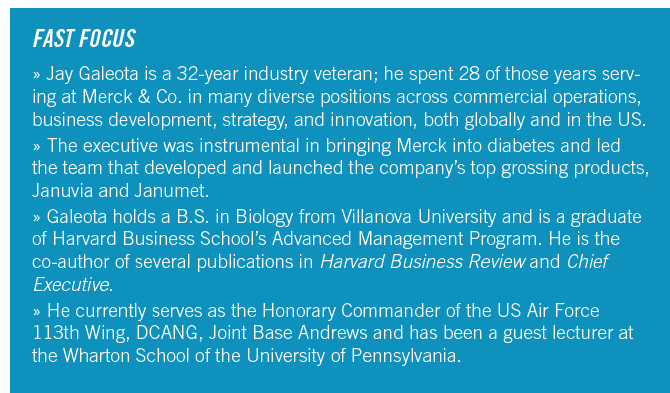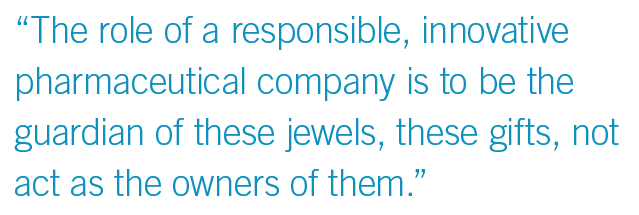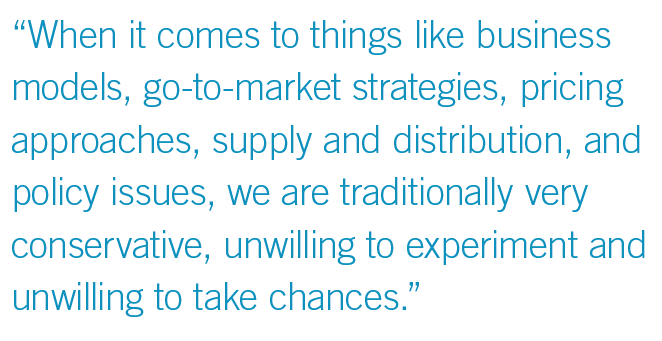Jay Galeota: A Better Way to Pharma
Veteran pharma leader Jay Galeota shares learnings and perspectives from an off-the-beaten-path career rise-one driven today by a mission to align the industry’s risk-taking approach across the entire drug life cycle.
Pharm Exec speaks with veteran industry leader Jay Galeota, currently president and CEO of Inheris Biopharma, Inc., who shares perspectives from a diverse, off-the-beaten-path journey-one driven today by his mission to align pharma’s risk-taking approach across the entire drug life cycle
Jay Galeota, President and CEO, Inheris Biopharma, Inc. Photo/John Halpern

When Jay Galeota entered the pharma industry through the doors of Merck & Co. in 1988, he questioned whether he belonged with this group of smart, over-achieving co-workers at then the world’s Most Admired Company, which was changing the practice of medicine globally and improving people’s lives. But Galeota felt blessed to be a part of Merck and surrounded by intellectual, quality individuals trying to do the right thing. This formed the basis for his career path and foundation for how he viewed what pharmaceutical companies and their leaders should aspire to be.
Galeota wasn’t so far out of his element, though he might have felt that way at the time. Clearly, Merck saw something in Galeota beyond his biology degree and four-year Air Force ROTC training, which in a world of best-laid plans, would have landed him a pilot seat in an F-16. An eyesight issue instead led Galeota down the road into a seat in the C-suite.
Galeota had heard it was harder to get into Merck than Harvard Business School, and he felt fortunate to come into the pharmaceutical industry when it was in its prime. Galeota describes a hallway at Merck’s research laboratory headquarters in Rahway, NJ, where the molecular structures of many of the world’s greatest medicines that came out of Merck’s lab through the 1940s, ’50’s, ’60’s, to today, hang above the hall.
He says, “I had the opportunity frequently to walk down that hallway and each time I did I was struck, really awestruck, by the magnitude of these medicines that had such dramatic impact on the health and wellness of humankind worldwide, and grateful that I had the good fortune of helping to bring many of these life-changing

medicines to people in need.”
And for 28-odd years, Galeota worked his way up at Merck, not in a step-wise fashion, but in roles that allowed him to step out of his comfort zone. “I’m most effective when I’m learning,” he says. “I find that when I’m comfortable, I’m not learning as much as when I’m uncomfortable. I was fortunate to take some off-the-beaten-path assignments that, traditionally, people would have viewed as risky, but in my mind, they were opportunities to trailblaze and try new things.”
With each role-from entry-level sales representative to President of G&W Laboratories and, today, President and CEO of Inheris Biopharma, Inc.-a new perspective, an insight, an intriguing observation came to shape Galeota’s vision for what constitutes the best-of-the-best of pharma and its teams.
The following are some highlights of Galeota’s roles and perspectives, sampled from his full professional pedigree.
- A sales rep at Merck, where “carrying the bag” gave Galeota an understanding of how healthcare is delivered, which is locally, in geographic communities. This has been and remains the case, not just in the US, but globally. How the pieces fit together and where the goals and objectives of the involved stakeholders are aligned, as well as conflicted, is an experience Galeota applied to his broader roles at Merck. He says that made him more effective at recognizing opportunities to positively influence care delivery and more mindful of how medicines were brought into various healthcare paradigms.
- In his multiple roles in primary care, including Executive Director, Atherosclerosis Franchise, and Senior Vice President and General Manager, Diabetes and Obesity Franchise, Global Human Health, Galeota learned about many different primary care therapeutic areas, and, again, how they affect the way medicine is practiced on the ground, and how Merck could impact patients’ lives on a large scale.
- As Integration Leader, Global Human Health, Galeota led the integration of the pharmaceutical and vaccine businesses when Merck and Schering-Plough merged in 2009. This was another assignment where Galeota went out of his comfort zone, and learned a lot in the process. Leaving the highly successful diabetes group, Galeota thought he lacked experience to lead an integration of this scale, but the results proved he had the instincts and requirements to be successful.
- Senior Vice President, Strategy and Business Development, Global Human Health, tasked Galeota with building two new functions and new capabilities within the commercial part of the now much larger post-merger Merck. He again became a student, learning the disciplines of business development and strategy in the process of creating the new organization.
- As Merck President, Hospital and Specialty Care, Global Human Health, a large business line that comprised 27 different products in seven therapeutic areas, which were all new to Galeota, the role gave him another significant opportunity to learn and work through improving the business through hard decisions.
- Chief Strategy and Business Development Officer and President, Emerging Businesses, was Galeota’s last role at Merck, and brought corporate-wide responsibility for strategy and business development, along with leadership of multiple new business and Merck’s corporate venture fund. This positioned Galeota for his next move to President of G&W Laboratories, a 100-year-old, family-owned specialty generics company.
After 28 years at Merck, Galeota thought he knew a lot about the pharma industry. But, again, he found
Jay Galeota: Fast Focus (click to enlarge)

himself with a tremendous learning opportunity. “The majority of the pharma industry in the US is not innovative pharma, it’s generics; that is a very different business model,” he says. “It’s a complex and really difficult one. The chance to lead at G&W was a great opportunity from which I gained a lot of insights to carry forward and inspired a commitment to ensuring affordable access to medicines for those who need them.”
Gifts of science
Galeota’s business decisions and professional trajectory were never far removed from his foundational view of science, and the hallway of innovation at Merck. “I feel passionate about the value of the pharmaceutical industry to humankind,” he says. “I feel like every discovery that these brilliant scientists have gifted us with are really gifts to humanity that must be guided in ways that ensure their full potential to improve human health is realized.”
Achieving this, Galeota believes, is the industry’s obligation. “The role of a responsible, innovative pharmaceutical company is to do just that-to be the guardian of these jewels, these gifts, not act as the owners of them,” he says. “And that is an important distinction because there are, rightfully, many stakeholders with legitimate, relevant interests in how these special innovations are applied to society.”
To carry that philosophy then into the role of the C-suite executive, believes Galeota, is to ensure that when those meaningful opportunities to improve human life appear, the executive does everything possible to bring them to patients. And do so in ways that ultimately convey the maximum benefit to humankind, while reflecting the true value of the therapy.
Galeota acknowledges that he came into the pharma industry in its golden age, shaped by a time when its new medicines and vaccines were quite literally changing the way medicine was practiced and impacting

millions of lives in positive ways. He believes that pharma is on the cusp of another wave of meaningful advance and that, with the right kind of leadership, the industry can experience a resurgence in image that more accurately reflects the positive impact it has on humankind. However, Galeota observes, “In many ways, I think some companies lost their way, and some of that belief in the purpose of our industry and the value it brings to the world got clouded by other considerations.”
If executives stick to a compass that comes from doing the right thing for patients and stakeholders-and keeps that focus front and center to the business-then the profits will come, Galeota contends. “And the profits will come in abundance if it’s done the right way,” he says. “It’s a formula that is often taken for granted or even shortcutted in our industry, and it’s a disservice to the industry when that happens.”
Risky business
One could view Galeota as a risk-taker. Who else would knowingly get into a 49.3’ x 16.7’ fighter plane, with speeds capable of 1,500 mph, fly a straight vertical up 18,000 feet in the air, roll upside down, and then skim the surface of South Jersey at 600 mph, 500 feet above the ground? Sounds like a risk-taker; Galeota, however, says no. “I think of myself as somebody that imagines the possibility of things, but I am also very thoughtful about analytics and assessment and trying to understand the plausibility and probability of things.”
The willingness to think originally and experiment in new environments does not necessarily equate with risk in Galeota’s mind.
“Investing heavily in intelligence, and I don’t mean the kind that’s between your ears, provides one with unique insights that frequently lead to unfair advantage when a new trail is being blazed,” he says. “The ability to accurately sense and assess probabilities helps minimize the riskiness of being out of one’s traditional comfort zone. Using the fighter plane metaphor, accurate radar, sensors, and intelligence are as important as creative agility in the art of surprise and outmaneuver in combat. The three Ps-possibility, plausibility, and probabilit

-are components of balance that I try to always bring to bear on decisions.”
That balance in Galeota’s own approach to risk is not one he sees operating at innovative pharma companies.
“At the industry level-and this has always intrigued me-is the existing dichotomy in pharma where we take enormous risk and make extraordinary investments over multiple years, on sometimes very little data, and organizations, within this industry, we are comfortable accepting this risk,” he says. “Yet, when it comes to things like business models, go-to-market strategies, pricing approaches, supply and distribution, and policy issues, we are traditionally very conservative, unwilling to experiment and unwilling to take chances, by and large. I think that’s why we are in the same paradigm that we have been in for decades with respect to those functions of the business.”
To take that unbalance, the extraordinary appetite for risk on the research, discovery, and development side, and apply the same desire for innovation in commercial, manufacturing, and go-to market models to more effectively get medicines to the people who need them, is something Galeota would like to change. It’s one ideal that he and his team at Inheris Biopharma were heavily committed to when the company was formed.
Team chemistry
The composition of a pharma company is its people, and they are, ideally, as Galeota first noted in the 90s, smart, achieving, professional, concerned, and ethical. In those early days at Merck, Galeota never feared that others had ulterior motives; he trusted his co-workers to have his back. Again, a moment in time that shaped Galeota’s views early on for the types of people he preferred to work with, and as he moved up the ranks, the people he preferred to manage and develop and choose for his teams.
“I look for people who start a sentence with ‘what if…,’ are positive and resilient, tell it like it is, have diversity of perspective and experience, but an absolute commonality around ethics and ethos, and who also enjoy the journey,” explains Galeota.
Being very careful around fit is an important attribute that executives and team leaders need to be cognizant of, he adds. “I heard years ago, and it’s stuck with me, that in the end, leaders are remembered for three things: who they hire, who they fire, and who they promote,” says Galeota. “It might be a trite statement, but there’s a lot of truth in it because it is what leads to extraordinarily high-performing teams. They are rare, but when we see them, they all tend to have similar characteristics, and it’s always around not only the skills, but also the chemistry of the people involved. Superior skills are expected, it’s the price of admission, but the chemistry-how individuals work together-is the spark that differentiates extraordinary from simply above average.”
There is also the secret sauce from “super teams,” and Galeota says he has been fortunate to have been on a number of them. The team Galeota led that brought Januvia and Janumet to market, and ushered Merck into the diabetes space, he attributes to the experience of people with different expertise-clinical, regulatory, early development, marketing, legal, and manufacturing-that came together and aligned on a common purpose and succeeded beyond expectations. “That’s the measure of a super team,” says Galeota. “When you’ve exceeded what others or even you thought was possible for yourself as an individual and the team as a group, that’s magic.”
This dynamic also played out in the integration of Merck and Schering, according to Galeota. “It was the result of this super team-the chemistry, the magic that excited us all about what we were doing, and the prospects of the unique opportunity that we had,” he says. Galeota adds that good leaders should look for that chemistry when gathering a team around a table. Is the dynamic just mechanistic, or is there a spark or reaction among members that could result in something that is greater than the sum of the parts?
Another super team Galeota was involved in was Merck’s Hospital and Specialty Care leadership team. When first formed, it needed to understand which of those seven businesses the company could win in, which they could improve upon, and which they may have lost competitive advantage in. “We had to fundamentally reshape the business in a way that enhanced growth, but it meant exiting some businesses that were led by members of our leadership team,” says Galeota.

But in doing so, those leaders stuck to what was right for the team and the enterprise. Galeota says each one, ultimately, ended up in better positions afterwards because they were focused on doing the right thing for the business and doing it the right way-and other leaders wanted people like that on their teams.
“For leaders, there is a fine line between belief in a path to success that others don’t see and ... folly. There can be a pet project, a view, an opinion that someone just won’t let go of,” says Galeota. “And the leader has to make the call to address that. Frequently, that is something a lot of leaders shy away from and, as a result, teams get stuck in mediocrity for too long.”
Mediocrity of individuals or teams can also lurk in another fine line between constructive vs. destructive discourse, says Galeota. While he’s a big believer that diversity of experience and the ability to voice an alternative opinion is a positive, with the best leaders instinctively seeking this out among their teams, sometimes discourse can drift to the negative.
“In those circumstances, you have to identify it and then work with the individual or individuals who are bringing the team down,” says Galeota. “And if they aren’t able to be coached into a contributory role, then in my experience, you have to make some changes.”
He adds of those decisions: “A lot of times it should happen sooner than it does. Many times teams linger at suboptimal composition because leaders are hesitant to make the change, and, frequently, I’ve seen once the change is made, the level of the team’s performance is remarkably impacted almost always to the positive.”
Reinforcing again the importance of balance, it is Galeota’s belief that the people who maintain that approach make the strongest leaders, and having balance in life and drawing on diverse experiences outside of work helps bring broader thinking to their business. For example, volunteering frequently brings fresh perspectives to individuals, as well as benefit to society. Just as appropriate work and life balance usually enables people to make more natural, creative, and considerate choices. While a 70-plus hour work week, for instance, is often equated with the road to professional success, Galeota disagrees.
“We all work hard, but balanced, thoughtful, diverse thinking is what separates the good from the great, and that’s frequently enhanced by balance in life, not how much time you spend in the office,” he says.
Galeota believes this balance-time for volunteering, time with family, time for activities that provide personal fulfillment-must be modeled from the top, or it just becomes rhetoric. The employees won’t trust that it is a principled and desired behavior, unless their leaders walk the talk themselves, and model the way.
Culminating visions
Honoring science. Believing pharma can operate both dutifully and profitably. Leading super teams and shaping employees. Innovation in all aspects of the business, not only the labs. Trust and balance. These are many of Galeota’s beliefs that have come together over decades of varied experiences. He saw a chance to build a new company reflective of these beliefs when Inheris was formed as a CNS-focused spin-out from Nektar Therapeutics last year.
“What swayed me the most to take this on was the quality of the people I met at Nektar,” says Galeota. “I was impressed with their leadership and science focus from the start, along with their clear desire to do things the right way. It seemed like an ideal fit.”
Galeota is optimistic about the future of pharma and the role that principled leadership will play in its continued impact on the world. But the challenge is great. The industry’s reputation has never been worse, he contends, which is disheartening for those who are dedicated to improving the quality of human life. Something is fundamentally wrong when an industry exists for the good of others, yet is viewed so poorly.
“The opportunity to innovate has never been greater, and innovation now moves beyond the discovery at the bench to how that brilliance is applied in practice in ways that maximize the potential benefit conveyed to people who are suffering,” says Galeota. “The creativity we each bring, and enable in others, matched with thoughtful assessment and analysis, will undoubtedly enable a new golden age of pharma if we focus on doing the right things the right way.”
Lisa Henderson is Pharm Exec’s Editor-in-Chief. She can be reached at lhenderson@mmhgroup.com
